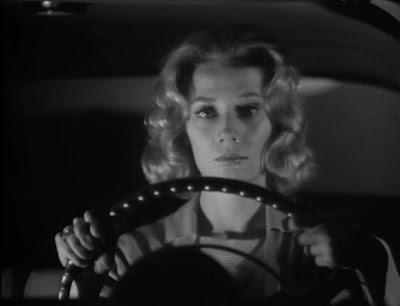(1962) Directed by Herk Harvey; Written by: John Clifford; Starring:
Candace Hilligoss, Frances Feist, Sidney Berger and Herk Harvey; Available on
DVD.
Rating: ***½
“We used black and white film and we were naïve enough to
hope for the look of a Bergman film and the feel of a Cocteau.” – Herk Harvey
(excerpt from Criterion DVD commentary for Carnival
of Souls)
“I didn’t so much invent the story and write it as much as I
did write the story and see what I had invented.” – John Clifford (ibid)
Some movies enjoy a second life, long after they were
originally written off. In the case of Carnival
of Souls, not only did the film gradually gain hordes of ardent admirers
after a limited (and disappointing) theatrical run, but it left an enduring legacy
that continues to be felt in horror cinema today. Like a zombie rising from the
grave, it took on a second life, establishing a new genre precedent for its
convergence of low and high-art aesthetics.
After making numerous educational films for Centron Corp, director
Herk Harvey and screenwriter John Clifford decided to try their hands at
feature filmmaking. Both took time off from their regular duties to shoot the
film, on a shoe-string budget of $30,000. Filming took place in Lawrence,
Kansas and Salt Lake City, Utah, where the climax takes place. Harvey
originally envisioned doing a series of films, but Carnival of Souls would prove
to be his sole theatrical outing.
Due to the miniscule budget, Harvey and his tiny crew relied
on existing locations for many scenes, including an early sequence in an organ
testing room. In this case, the filming location determined the central
character’s profession, as a church organist. The main attraction, however, is the
eerie, abandoned Saltair resort, sitting on the edge of the Salt Lake in Utah.
Once a prime destination for vacationers at the turn of the 20th
century, the once grand tourist resort had gone to seed by the ‘50s. The derelict
midway takes on an ethereal, otherworldly quality. The crumbling walls and
creaky floorboards of an immense dance hall becomes a tomb, only fit for ghosts
to inhabit.
Candace Hilligoss turns in a frustrating, enigmatic
performance as the film’s nominal protagonist, Mary Henry. She’s the lone
survivor of a disastrous road race, when the car she and her friends are
occupying careens off a bridge and sinks in a river. She manages to pull
herself out of the water, stunned but intact. Mary spends the rest of the film
walking in a perpetual haze, as she lapses in and out of lucidity. After her
near-death experience, she accepts a job in another town. Despite her skill,
she doesn’t see her calling as a church organist, but instead comments “…a
church is just a place of business.” She’s not out to re-invent herself as much
as run away from her past, and continue to keep others at arms’ length. In one
scene, she comments to a doctor, “I don’t belong in the world. Something
separates me from other people.” Although her character is difficult to connect
with as a viewer, many of us can identify with her feelings of isolation and
alienation, exemplified by her frequent separations from reality. In a shot that
evokes Janet Leigh’s character in Psycho,
or Inger Stevens in the Twilight Zone
episode “The Hitch-Hiker,” she drives into the night to an uncertain future. She’s
a lost woman, haunted by a pallid apparition* only she can see. She’s
inexplicably drawn to an old, moldering pavilion. She wanders the empty
carnival grounds, at once looking for something she’s lost, but unable to make
the vital connection. The filmmakers don’t supply many clues about her
motivation – Is her dissociative state a result of trauma from her automobile
accident or something else?
* In a decision based on “ego and economics,” Harvey played
the ghostly man who relentlessly pursues Mary.
Audiences didn’t pay much attention during Carnival of Souls’ first go-round. It
received a relatively limited release, mainly in the South, on a double bill
with the Lon Chaney, Jr. flick The
Devil’s Messenger. But thanks to nightmare-like imagery and an ambiguous
story, it’s built a solid cult following over the years. Harvey and Clifford,
by accident or design, created a horror film for the arthouse crowd, but were
nevertheless amused by the numerous interpretations over the years. While the
film doesn’t quite possess the same power to surprise modern audiences (anyone
who’s ever seen an M. Night Shyamalan movie will likely see the ending coming a
mile away), what remains is a grim portrait of a limbo world between the living
and the dead (Although I must admit, spending purgatory in an old amusement
park wouldn’t be so bad as long as the rides worked).
With all due respect to Carnival
of Souls’ cult classic status, it’s a trifle underwhelming, perhaps more
famous for the films it inspired (notably, the superior Night of the Living Dead) rather than the original product. It’s a creaky
boat, hampered by an unsympathetic lead, unlikable supporting characters
(especially Mary’s oafish neighbor, played by Sidney Berger) and a languid pace.
But faults aside, it’s impossible to dismiss the film’s influence on the horror
genre. The filmmakers did so much with so little, and it’s commendable that Harvey
and company left so much purposefully vague. Compared to many other horror
films from that era, or contemporary horror films for that matter, it was a bold
step to retain an air of ambiguity throughout. Carnival of Souls boasts some impressive cinematography, memorable
location scenes, and still possesses the power to creep us out.








No comments:
Post a Comment